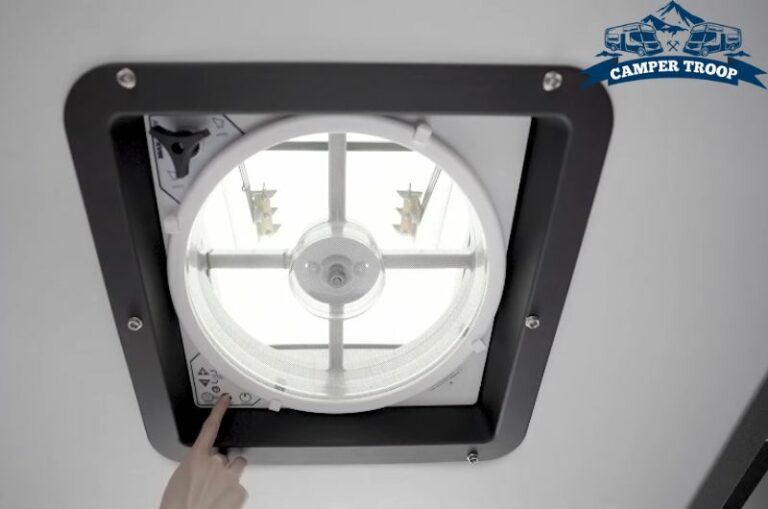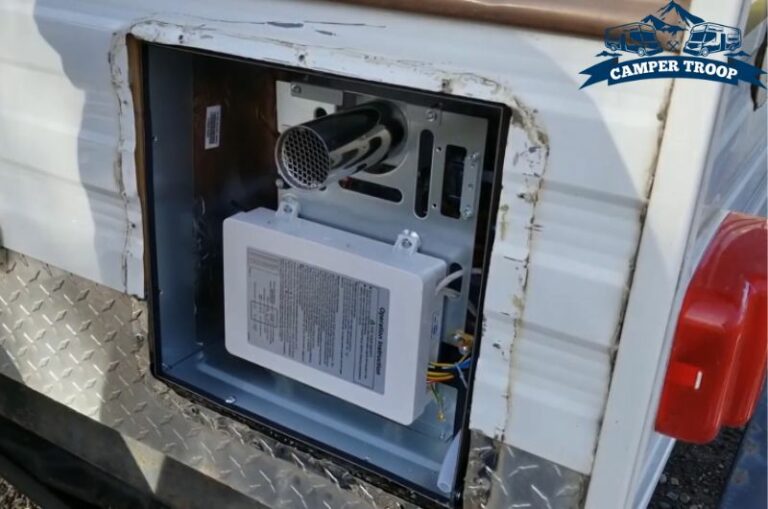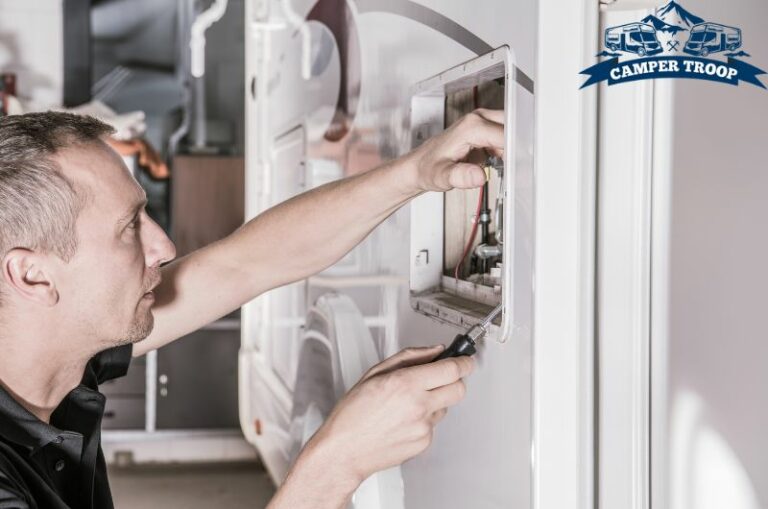Complete Guide on How to Jack Up a Travel Trailer in 4 Steps
Often, jacking up the travel trailer is necessary to look at specific areas or troubleshoot issues with it. For example, I had to jack up mine last week to change its flat tires and it only took me about fifteen minutes to do it on my own.
So how do you jack up a travel trailer so quickly? I found Jacking up the trailer at its backing plate using a hydraulic bottle jack to be the best approach from my research online and some hands-on experience. However, additional factors should be taken into account as well.
If you need to jack up a travel trailer but have never done it before, here’s a simple step-by-step guide based on my own experience.
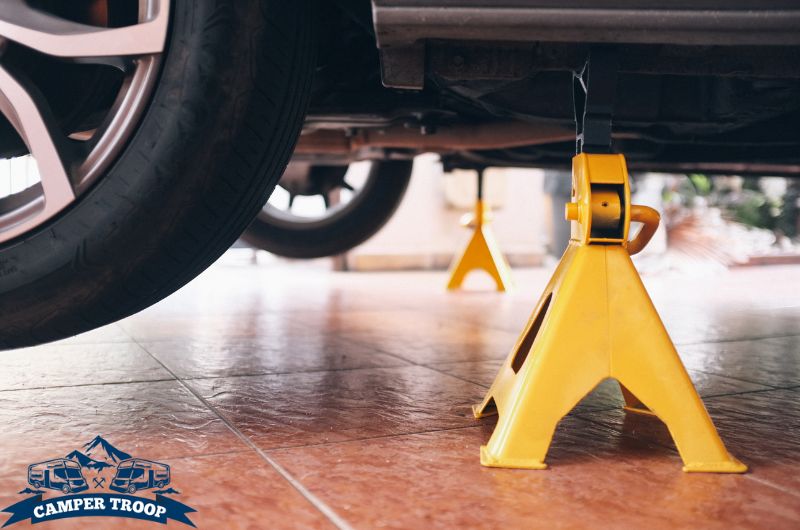
Why Jacking Up at the Backing Plate Instead of the Axle?
The backing plate is where the travel trailer’s brakes are located. It’s also where the jacks for the tongue of the trailer are typically located.
You’ll want to jack up your trailer at the backing plate for several reasons. For one, it helps distribute the weight more evenly and takes some pressure off the axle.
Source: https://www.forestriverforums.com/forums/f88/how-to-jack-up-trailer-17027.html
It’s also helpful to jack up the trailer at the backing plate for making adjustments to the brakes or attach/detach the tongue. Besides, it helps to have the trailer consistently level when working on it, and jacking it up at the backing plate will help achieve this.
This also makes it safer than jacking it up at the axle, which some prefer. Taking one example, one of my camping buddies once tried the axle to change a tire and ended up shattering the beams, which wasn’t fun at all.
Read Also: What Causes Tecma Rv Toilet Red Light? (Explained)
How to Jack Up a Travel Trailer in Four Steps
As mentioned, a bottle jack is going to be your best friend for this task because of its excellent weight distribution capabilities. Apart from that, there are a few more tools you’ll need.
Tools Needed
- A set of wheel chocks: Using these will help keep your trailer from rolling while you’re jacking it up. You can find them at any hardware or automotive store.
- A jack stand: You’ll need this to support the trailer once it’s jacked up. You may want to use a few wood blocks instead, but that may slip and cause the trailer to fall.
- Extensions: Travel trailers are usually 15-25 inches above the ground, so you may need an extension for the bottle jack to reach it for achieving the correct height.
- Jack pads: You may also want to use a flat or round jack pad when levitating your trailer’s suspension or gripping the frame beneath the trailer for preventing any damage.
Once you have all these tools, jacking up a travel trailer is a four-step process. For the following procedure, I used a 22-inch hydraulic bottle jack for my travel trailer, which is about 19 feet long. However, you can use a smaller one if your trailer is closer to the ground.
Read Also: How Much Can A Chevy Suburban 2500 Tow? (Capacity Chart)
Step One: Park Your Trailer on a Flat Surface
This one is pretty self-explanatory. If your trailer isn’t parked on a level surface, it may topple over while jacking, which could cause serious injury. Also, use the wheel chocks on both sides of the trailer’s wheels to keep it from moving after parking it well.
Source: https://www.youtube.com/watch?v=Tfn-m9WHeRM
Step Two: Place the Bottle Jack Under the Backing Plate
We now place the bottle jack under the backing plate of the trailer. You’ll want to make sure that it’s centered and as close to the axle as possible. As I figured out the hard way, if it’s too close to the edge, the trailer may tip over.
Source: https://www.youtube.com/watch?v=Tfn-m9WHeRM
After securing it to the jack stand, tighten the extension plugs to fix the jack height. A flat or round jack pad should be placed on the jack’s top.
Step Three: Jack Up the Trailer
Once the bottle jack is in place, start jacking up the trailer until the desired height is achieved. You can now place the other jack stands under the frame or suspension to support it.
Source: https://www.youtube.com/watch?v=Tfn-m9WHeRM
If you’re only jacking up one side of the trailer, make sure to jack it up high enough so that the other side is also lifted off the ground. This will help distribute the weight more evenly and prevent any damage to the frame.
Step Four: Lower the Trailer
Once you’re finished working on the trailer, it’s time to lower it back down. Start by removing the jack stands from under the frame or suspension. After that, slowly lower the trailer back down to the ground by releasing the pressure on the bottle jack.
Source: https://www.youtube.com/watch?v=Tfn-m9WHeRM
And that’s it! You’ve now successfully jacked up your travel trailer.
Read Also: Why 15 Amp Fuse Keeps Blowing In Rv: How to Fix it?
Frequently Asked Questions
Below, I have answered a few frequently asked questions regarding jacking up a travel trailer.
Why use a bottle jack to jack up a travel trailer?
A bottle jack is more stable than a floor jack and it can distribute the weight more evenly. Plus, it can reach higher heights and can be placed closer to the axle, where the trailer’s weight is concentrated, contributing to its ease of use. Besides, hydraulic bottle jacks require much less energy.
What size jack should I use for my travel trailer?
The size of the jack will depend on the length and weight of your trailer. For example, I used a 22-inch bottle jack for my travel trailer, which is about 19 feet long and weighs around 5,000 pounds. In general, you’ll want to use a bottle jack that can lift at least half of the trailer’s weight.
Can I use a floor jack to jack up my travel trailer?
You can. Just make sure that the jack is rated for the weight of your trailer and that it can reach the height you need. Besides, take note that a floor jack is not as stable as a bottle jack, so you’ll need to be extra careful and use additional support when using it.
Can I use a scissor jack to jack up my travel trailer?
Yes, but I don’t recommend it. Scissor jacks are far less stable because of their smaller base. Plus, they can’t reach as high as bottle jacks, which means you won’t be able to place jack stands under the frame or suspension.
Is it safe to jack up a travel trailer by its axle?
Mostly not. The axle is not as strong as the frame, so jacking up a travel trailer by its axle can cause it to bend. Or worse, it can crack the beams and tip the trailer over. If you must jack up the axle, use multiple jack pads to distribute the weight evenly and prevent any damage.
Read Also: What Is Fullway Termination Valve: And Where Is It Located?
Conclusion
As you can see, jacking up a travel trailer is easier than it may seem. Anyone can do it with the right tools and a little know-how.
And hopefully, this quick guide will stand you in good stead should you ever need to do something similar to your own travel trailer.
On a final note, remember to always use caution when working with tools and heavy machinery, and always have someone around to help you in case something goes wrong.
Read Also: When To Use The Check Valve, Before Or After Pump? Find Out!

Zayan is an accomplished author and a go-to expert for all things RV and camper-related. With a passion for adventure and a knack for problem-solving, he has spent years exploring the open road and fine-tuning his knowledge of recreational vehicles.
Zayan’s writing is a testament to his expertise, offering readers practical solutions to common RV dilemmas. Whether it’s troubleshooting mechanical issues, optimizing space, or planning the perfect road trip, Zayan’s insightful advice and engaging storytelling make him an invaluable resource for both seasoned travelers and newcomers to the world of RVing.


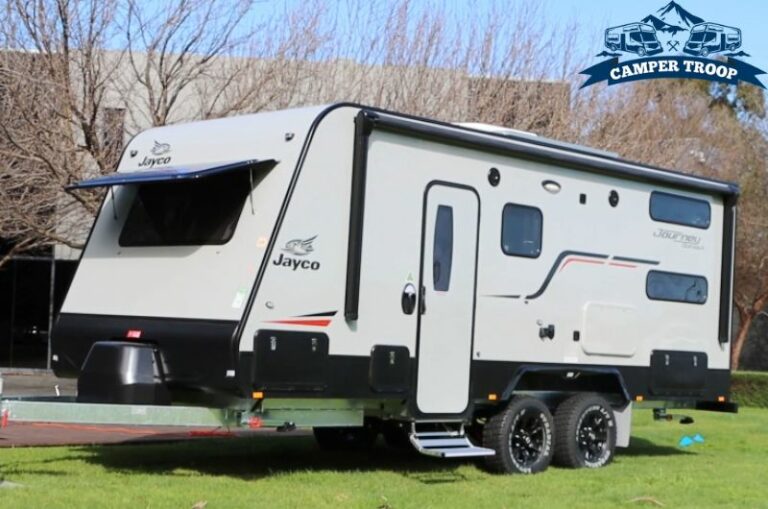
![5 Common Problems with Winnebago Aspect [Solutions Included]](https://campertroop.com/wp-content/uploads/2022/01/Winnebago-Aspect-Problems-768x509.jpg)
